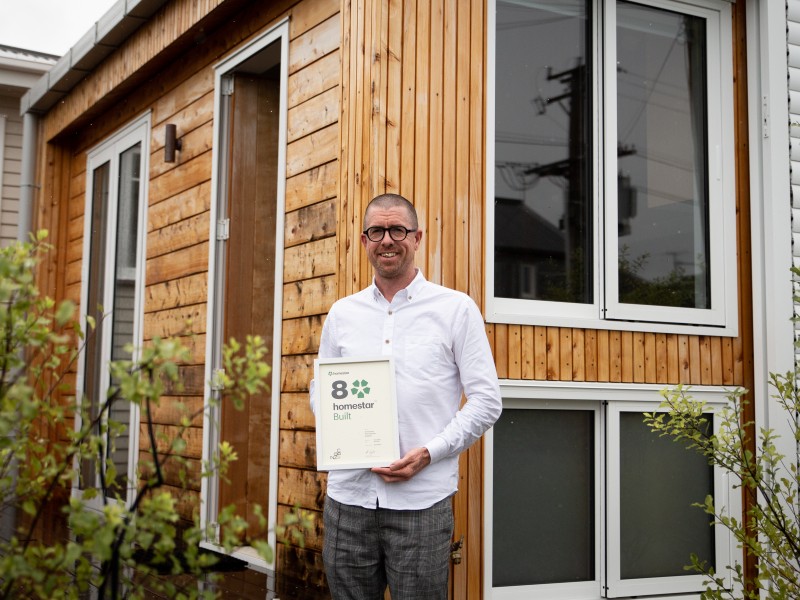“It’s a reflection of collaboration, people sharing their knowledge, sharing their passion and everyone coming onboard,” owner Simon Wilson says.
Project Summary
Rating: 8 Homestar
Location: Tui Street, Pt Chev
Owners: Sarah and Simon Wilson
Completion: February 2020
Size: One bedroom house, 45m2
Built on his Point Chevalier front lawn, the 45m2, one-bedroom house has been awarded an 8 Homestar rating, joining the Commended Award already on the mantel from the 2020 Auckland Northland ADNZ Resene Architectural Design awards.

“It had two design iterations. The first was one from a friend of mine Jonathan Walker and the brief was to create a jewel.”
“Jonathan created something that was much more radical than this but absolutely, completely unaffordable. It was exceptional, but out of reach.”
Simon then asked his brother-in-law Haden Kose of BK Design to reimagine the design. Haden is skilled at creating stunning but affordable spaces.
“He took the unobtainable aesthetic and converted it into a beautiful practical, multifunctional space. That was when Homestar and all the sustainable features were engrained into the brief.”
Project Team
Architectural Designer: Haden Kose, BK Design
Homestar Assessor: Matt Wilson, Eco Insite Ltd
Builder: FTB Construction
Thermal modelling: MESH
Surrounded by crisply painted homes, the bare timber clad house stands in stark contrast. That is, with one exception. The nest, as Simon calls it, sits opposite the Zero Energy House – a home that produces as much energy as its occupants use.
“We used macrocarpa weatherboards and that enabled a few things; firstly, to borrow brilliance from across the road, but also from an urban design perspective these two buildings now speak to one another other. Where before it was the freak on the street suddenly it’s normalised or enhanced.”
“I work with them constantly. They’re my friends so they’re happy I stole their stuff.”
He says the building was informed in many ways by the team at the Zero Energy House, borrowing features such as a wide envelope to allow for high levels of insulation.
“Part of the zero-energy home ethos, and their personal ethos is that construction is terrible for making prototypes every time - you should be sharing knowledge and improving. That’s really what we should be doing as an industry rather than consistently making mistakes.”
With sustainability and the Homestar framework new for many involved, collaboration was key across the design and build. Led by Simon and his wife Sarah, as well as Homestar assessor Matt Wilson (no relation) the wider project team were quick to get behind the brief and innovate.
“We’ve got screw piles, that was our builders’ James Mackay (FTB construction Managing Director) idea – they said why not try these out. We got them verified by the NZGBC as appropriate, and I’m the biggest fan of screw piles now. “
“Tapping into the psyche of the people you’re partnering with and getting them to feed their great ideas into it is really rewarding.”
He’s also paying it forward already, with the project’s efforts shared with others interested in following in their footsteps.
“I would have given the plans for this home to 8-10 people who’ve come by, looked at it, loved it and wanted to learn from it. So, it’s open source - here it all is and here’s what I’d do differently next time.”
Creating a sustainable space
The home has been awarded an impressive 8 Homestar rating, however Simon Wilson says the focus wasn’t on a specific number but rather, achieving great outcomes.
“Once you have a goal and there’s a cascade effect, that’s more meaningful from my perspective.” I’m a firm believer in using sustainable rating tools, initiatives to empower the brief or to lay the foundation for the use of the building.”
Solar panels provide energy to the building which is\has a high performing thermal envelope, efficient fittings and hot water supplied via an efficient heat pump.
“If you have got the privilege of building something new, try to engineer it so that it doesn’t use as much energy in the operational phase as it creates. It hasn’t even been a year yet but we’re on track to have produced more energy with the solar panels than we will use.”
He says the biggest challenge was sourcing sustainable materials and products that aligned with the requirements of Homestar.
“The fun part of the process was getting to watch other people be frustrated with trying to do the right thing. It is just harder, you’ve got less products you can choose from, they’re harder to get hold of. I think that was an eye opener for the builder and everyone. It’s unfortunate but you’re a bit of a pioneer so it’s a bit of extra effort.” “
Despite the challenges, he says they were close to getting a higher rating
“There would be things we could do to this building to get 9 Stars, it was very close to it, but we wouldn’t necessary have been authentic with how it’s going to be used. We’ve done things we believe in and that’s been recorded and celebrated with an 8 Homestar rating and we’re really proud of that.”
“The really rewarding part of it all is we can now say ‘yeah we’ve pulled all these people together, they’ve created this‘ - I still think it’s a jewel, it’s just a less expensive, more eco-friendly jewel. “
Sustainable features include:
- Water and energy efficiency rated appliances
- E-Bike and electric car charging
- Sustainable materials including Greentag level A certified GIB, insulation, applied coatings and EPD certified concrete.
- Passive solar design
- Edge and under slab insulation
- No steel in walls or ceilings
- Over 75% of waste diverted from landfill including over 2 tonnes of hardfill, 1.3 tonnes of timber, and almost 200kg of steel.
